
As a self-taught chef, I have always enjoyed watching other chefs and cooks work whether in-person or on screen. Even if I’m just watching something for leisure I will always file away any interesting tips I pick up from a peek into how another cook works. So when I was recently watching a video of a chef on YouTube and saw an approach to refreshing slightly wilted greens that I had never encountered before I definitely took note, and decided to try it out myself.
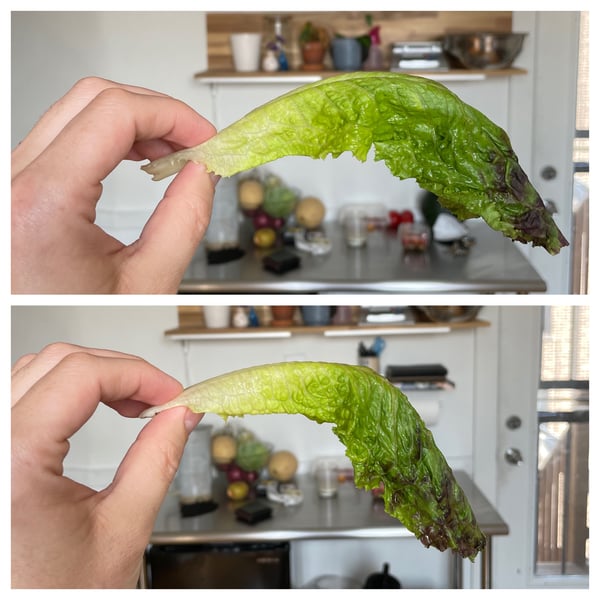 Typically if you ask a professional cook how to refresh wilted greens, they will tell you to plunge it into ice water for a bit before drying and using. This approach works reasonably well depending on the level of wilting and the type of green. If you google the question, you will get pages upon pages of this exact advice. However, this chef I was watching had a different technique. He submerged his greens in warm water, then put them in the refrigerator to cool down and crisp up. It certainly seemed to work in the video, but this felt incredibly counter-intuitive to me. I think most cooks spend a lot of time trying to make sure delicate greens and herbs don’t warm up. Warming up that kind of produce is usually the main cause of wilting in the first place, so to think that it could also be the solution felt a little backwards. Yet the results in the video were impressive enough that it definitely warranted further investigation.
Typically if you ask a professional cook how to refresh wilted greens, they will tell you to plunge it into ice water for a bit before drying and using. This approach works reasonably well depending on the level of wilting and the type of green. If you google the question, you will get pages upon pages of this exact advice. However, this chef I was watching had a different technique. He submerged his greens in warm water, then put them in the refrigerator to cool down and crisp up. It certainly seemed to work in the video, but this felt incredibly counter-intuitive to me. I think most cooks spend a lot of time trying to make sure delicate greens and herbs don’t warm up. Warming up that kind of produce is usually the main cause of wilting in the first place, so to think that it could also be the solution felt a little backwards. Yet the results in the video were impressive enough that it definitely warranted further investigation.
I decided to start with a google search to see if this method was already well established, and I had just missed it in my time in professional kitchens. I didn’t perform a completely exhaustive search, but I found essentially no results. Some sort of adjacent (and very interesting) results (for another post…), but nothing describing a method of refreshing greens using warm water before crisping in the fridge. Just page after page of the same ice-water method I described above. Interesting.
I decided to try out a little test where I pit the two methods against each other so I could have a direct side-by-side comparison. Of course, the clip where this technique is shown is just a few seconds long, and doesn’t provide any details about the actual method, so I had to make up my own protocol.
I began by taking four leaves of romaine lettuce and clipping some parsley from my herb garden, and leaving it out in the sun for a few hours...
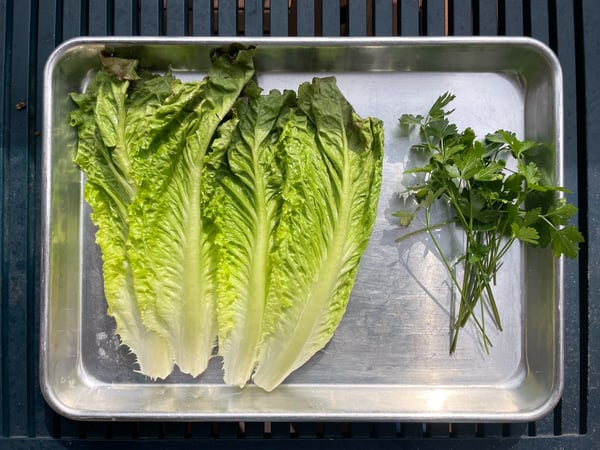 ... until they were nice and wilted.
... until they were nice and wilted.
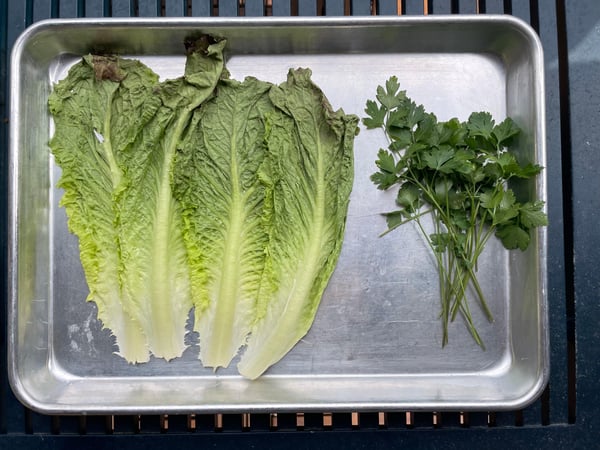 Then it was time to refresh. I knew I was going to do half in an ice-water bath, but the warm water bath was a bit of a mystery. What did warm mean? Room temp? Body temp? Bath water temp? Who’s to say? I settled on around 105 F, which is right around the temperature where the water transitions from “kinda hot” to “oh, that’s pleasant”. A pretty fuzzy, subjective target, but it felt right.
Then it was time to refresh. I knew I was going to do half in an ice-water bath, but the warm water bath was a bit of a mystery. What did warm mean? Room temp? Body temp? Bath water temp? Who’s to say? I settled on around 105 F, which is right around the temperature where the water transitions from “kinda hot” to “oh, that’s pleasant”. A pretty fuzzy, subjective target, but it felt right.
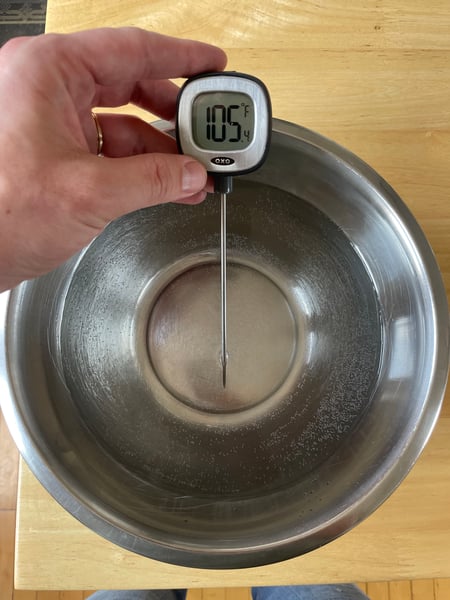 I then split up the parsley and lettuce, and put half in each water bath.
I then split up the parsley and lettuce, and put half in each water bath.
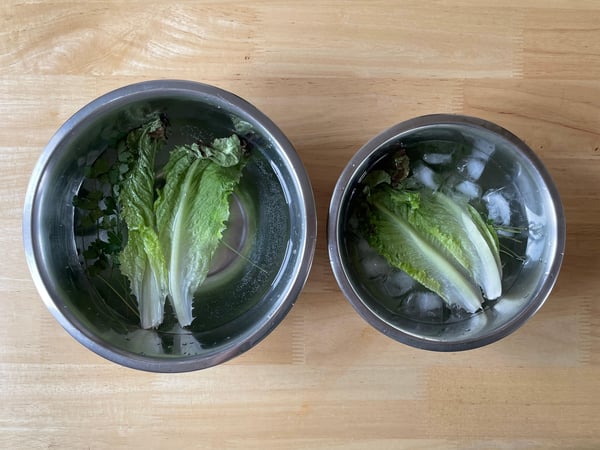 I decided to let them rest in the bath for five minutes. I figured this would be enough time for whatever was going to happen to happen. Maybe a second test could lengthen this period of time. I pulled greens out after five minutes, rain them through a salad spinner, and laid them out on separate towel lined sheet trays.
I decided to let them rest in the bath for five minutes. I figured this would be enough time for whatever was going to happen to happen. Maybe a second test could lengthen this period of time. I pulled greens out after five minutes, rain them through a salad spinner, and laid them out on separate towel lined sheet trays.
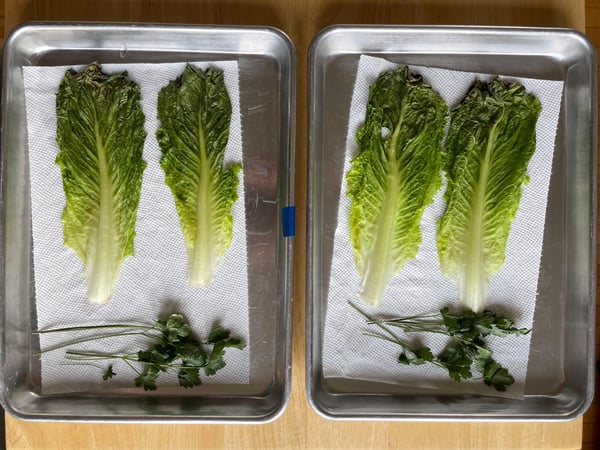 I marked the one that had gone in the ice bath with a piece of blue tape, then put them both in the fridge for 40 minutes to give plenty of time for the greens to crisp up before taking them out to judge the results.
I marked the one that had gone in the ice bath with a piece of blue tape, then put them both in the fridge for 40 minutes to give plenty of time for the greens to crisp up before taking them out to judge the results.
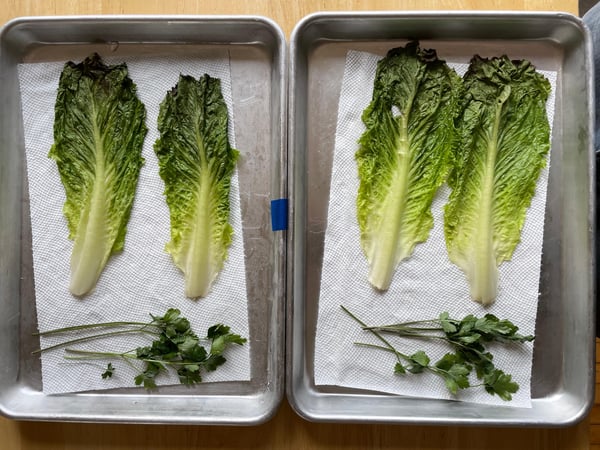 To be honest it didn’t seem like either technique had worked especially well on the lettuce, though it was on the old side to begin with, and these techniques usually work best with produce that has wilted from heat rather than age. That said the results did show some differences. In the image below, the top shows the results from the warm water bath, and the bottom shows the results from the ice water bath.
To be honest it didn’t seem like either technique had worked especially well on the lettuce, though it was on the old side to begin with, and these techniques usually work best with produce that has wilted from heat rather than age. That said the results did show some differences. In the image below, the top shows the results from the warm water bath, and the bottom shows the results from the ice water bath.
 And in the next image, the left side shows the warm water bath, and the right shows the ice water bath.
And in the next image, the left side shows the warm water bath, and the right shows the ice water bath.
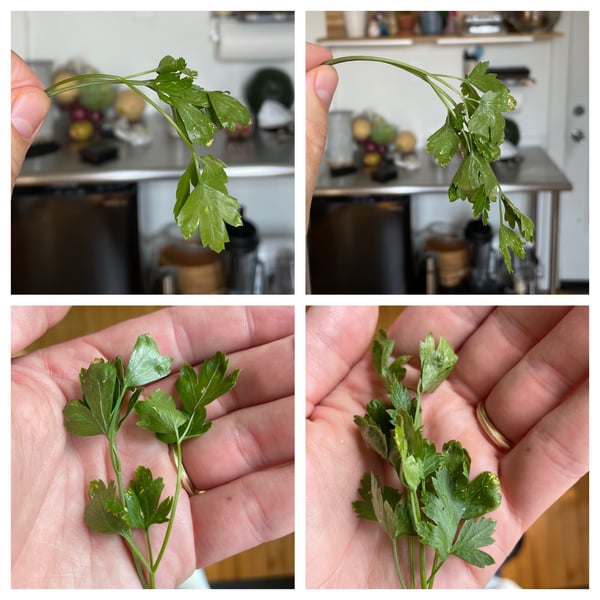 With results this close, I hesitate to make any real proclamations about efficacy without further tests, but it certainly looks like in this case the warm water bath did a slightly better job at refreshing the herbs and lettuce than the ice water bath. At the very least we can say the warm water bath does not in any way harm the vitality of the produce in the way I would have assumed it would had I never tested it. I’m not really sure what’s going on here, but perhaps the warmer water allows more water to circulate into the vascular system of the plant before it goes into the fridge. It would be interesting to see how a very long ice water rest compares to these two methods as well. At any rate, I’ll certainly be keeping this in mind the next time I need to bring some vivacity back to my greens, because in my household ice is precious and takes a long time to make, so using a whole tray in an ice bath is always a bummer.
With results this close, I hesitate to make any real proclamations about efficacy without further tests, but it certainly looks like in this case the warm water bath did a slightly better job at refreshing the herbs and lettuce than the ice water bath. At the very least we can say the warm water bath does not in any way harm the vitality of the produce in the way I would have assumed it would had I never tested it. I’m not really sure what’s going on here, but perhaps the warmer water allows more water to circulate into the vascular system of the plant before it goes into the fridge. It would be interesting to see how a very long ice water rest compares to these two methods as well. At any rate, I’ll certainly be keeping this in mind the next time I need to bring some vivacity back to my greens, because in my household ice is precious and takes a long time to make, so using a whole tray in an ice bath is always a bummer.
If you enjoy learning minutiae-based tips and tricks, consider checking out an upcoming session of our Culinary Boot Camp where us instructors get the chance to go in depth into technique, and you get to ask all the questions you’ve ever wanted the answers to.

